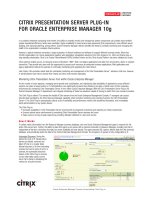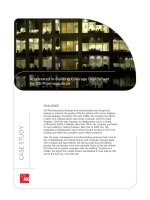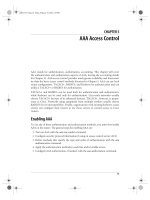Tài liệu Equal Access Means Equal Opportunity for All: Creating a Real-Time Statewide Advanced Placement Consortium February, 2003 ppt
Bạn đang xem bản rút gọn của tài liệu. Xem và tải ngay bản đầy đủ của tài liệu tại đây (638.79 KB, 20 trang )
1
Equal Access Means Equal Opportunity for All:
Creating a Real-Time Statewide Advanced
Placement Consortium
February, 2003
2
AP Consortium Purpose
AP Consortium Purpose
Increase the accessibility to advanced
placement courses for Wisconsin’s
rural, low income, and minority
students by using “real time”
classroom instruction delivered over
Wisconsin’s fiber optic BadgerNet.
3
4
Project Concept
WADEN
AP STUDENT
AP CONSORTIUM
TEACHER
SCHOOL
COUNSELOR
UW-MADISON
(TRAINING)
CEW ADVANCED PLACEMENT CONSORTIUM
5
•
Almost a quarter of Wisconsin’s public secondary
schools cannot/do not offer a single AP course.
•
Of the remaining schools that offer AP courses, ¾ offer
only one or two per year.
•
RESULT: Talented and ambitious students in these
schools are at a distinct disadvantage when they compete
against their college bound counterparts from schools
with greater accessibility to AP course work.
Inaccessibility Dilemma
6
Inaccessibility Cycle
•
School size, student interest, and local budget resources
School size, student interest, and local budget resources
determine availability of local AP courses in Wisconsin.
determine availability of local AP courses in Wisconsin.
•
Low student interest for AP courses in rural or urban schools
Low student interest for AP courses in rural or urban schools
indirectly excludes learners who wish to take rigorous, college
indirectly excludes learners who wish to take rigorous, college
level courses while in high school.
level courses while in high school.
•
Low student participation rates in AP
Low student participation rates in AP
courses make it exceedingly difficult to
courses make it exceedingly difficult to
allocate scarce local teacher resources to AP
allocate scarce local teacher resources to AP
instruction.
instruction.
•
Unavailability of AP courses preclude
Unavailability of AP courses preclude
guidance counselors from promoting these
guidance counselors from promoting these
types of courses to their students.
types of courses to their students.
7
Example of the Impact That This
Inaccessibility Cycle Can Have
"I just wanted to drop you a line to say that I find your AP project very interesting- I come
"I just wanted to drop you a line to say that I find your AP project very interesting- I come
from a small, rural high school that did not offer any AP courses. In fact, I was told by the
from a small, rural high school that did not offer any AP courses. In fact, I was told by the
middle school guidance counselor that high school students weren't capable of handling
middle school guidance counselor that high school students weren't capable of handling
college level work, so AP was a bad idea!
college level work, so AP was a bad idea!
However, in the summer of 1991 I was fortunate enough to be able to attend a pilot program
However, in the summer of 1991 I was fortunate enough to be able to attend a pilot program
at the University of Iowa called the Advanced Placement Academy. The Academy consisted of
at the University of Iowa called the Advanced Placement Academy. The Academy consisted of
AP classes in English, History, Biology, and Mathematics, which were condensed into six-
AP classes in English, History, Biology, and Mathematics, which were condensed into six-
week, intensive courses. Students enrolled in one of the four courses, and at the end of the
week, intensive courses. Students enrolled in one of the four courses, and at the end of the
coursework, took the appropriate AP exam. I took the English course which turned out to
coursework, took the appropriate AP exam. I took the English course which turned out to
be the most valuable instruction in composition and literature I had during my entire high
be the most valuable instruction in composition and literature I had during my entire high
school career. In fact, the admissions counselor [at the college] where I did my undergrad told
school career. In fact, the admissions counselor [at the college] where I did my undergrad told
me that if I hadn't taken AP English, they would have been reluctant to let me in.
me that if I hadn't taken AP English, they would have been reluctant to let me in.
I don't know how relevant my experience may be to your project,
I don't know how relevant my experience may be to your project,
but the extension of AP courses to rural kids is kind of
but the extension of AP courses to rural kids is kind of
near and dear to my heart."
near and dear to my heart."
[Email correspondence to John Gugerty, AP Consortium Project Director, 12/3/02.
[Email correspondence to John Gugerty, AP Consortium Project Director, 12/3/02.
Quoted with permission.]
Quoted with permission.]
8
NUTS & BOLTS
PLAN OF ACTION I
Create, operate, and maintain a statewide advanced
placement distance learning clearinghouse for all
Wisconsin high schools.
The AP Consortium staff will:
–
Recruit AP teachers
–
Arrange for their summer training at UW-Madison or
Lawrence University [Appleton]
–
Help principals and counselors make a wide range of AP
distance learning courses available to their students
–
coordinate fiscal transactions required to participate.
9
NUTS & BOLTS
The AP Consortium will utilize each school’s
existing distance learning (DS-3/fiber optic)
teleconferencing facilities as the primary
instructional delivery platform.
PLAN OF ACTION II
10
NUTS & BOLTS
PILOT YEAR PROJECT OBJECTIVES
•
Recruit as many as 25 AP Consortium high schools with
two AP Consortium teachers per school.
•
Enroll as many as 500-700 AP students to participate in
the AP Consortium courses for the 2003-2004 school year.
•
Conduct an AP Consortium summer training course at
UW-Madison and Lawrence University for AP teachers.
–
AP Instructional Content: UW Division for Continuing Studies and
Lawrence University
–
AP Distance Education Approaches: UW Extension
•
Create, implement, and then expand the AP Consortium
infrastructure for all participating schools.
11
NUTS & BOLTS
•
problem-solving teaching strategies
•
how to use a variety of contexts and
constructs
•
how to monitor and direct the distance
learner
•
how to best utilize distance learning
technology
•
how to employ authentic assessment in a
distance learning environment.
During the 2003 AP Summer Training, AP
Consortium teachers will learn:
12
NUTS & BOLTS
INSTRUCTIONAL DELIVERY
Students will participate in their AP Consortium courses
in their respective schools in a “real time” environment.
AP Consortium teachers may supplement this “real time”
instruction through use of web pages created and
supported by the AP Consortium staff. Teachers can use
these websites to post and receive assignments, provide
on-line readings, or conduct other learning activities.
13
C
E
N
T
E
R
O
N
E
D
U
C
A
T
O
N
A
N
D
W
O
R
K
U
W
A
D
V
A
N
C
E
D
P
L
A
C
E
M
E
N
T
I
N
S
T
I
T
U
T
E
U
W
-
E
X
T
E
N
S
I
O
N
S
C
H
O
O
L
O
F
E
D
U
C
A
T
I
O
N
UW-MADISON PARTICIPANTS
14
NUTS & BOLTS
AP Consortium Benefits: STUDENTS
Wisconsin’s rural and urban student populations will:
Get ahead by earning college credits before they leave high
school
Save themselves thousands of dollars in college costs.
Enable them to expand and sharpen their existing
academic skills
Assist them in creating a more competitive admissions
package for the more select colleges
Learn in a high-tech distance learning environment
15
NUTS & BOLTS
AP Consortium Benefits:
SCHOOL DISTRICTS
Rural and/or low income school districts can:
•
Employ economies of scale as they pool their AP
teacher talents with other school districts
throughout the state of Wisconsin;
•
Begin to “level the playing field” of postsecondary
preparation for their students;
•
Provide incentives to strengthen curricula that
provide the foundation for these AP courses.
16
NUTS & BOLTS
•
Increase their professional skills
•
Increase their employment opportunities/security
•
Enrich their professional lives
•
Enhance their employability in other educational
settings
AP Consortium Benefits:
TEACHERS
17
NUTS & BOLTS
The project will fund as many as fifty AP Consortium teacher
summer training scholarships in Project Year 1. These
scholarships will pay for the AP teacher’s room, board, and
tuition incurred during a four day AP Consortium professional
development course that will be offered at the University of
Wisconsin-Madison and at Lawrence University, Appleton,
beginning in June, 2003.
AP Consortium Benefits:
TEACHERS II
18
NUTS & BOLTS
•
Enhance campus diversity initiatives and results by
developing and expanding a pool of students whose
preparation will enhance their desire and ability to
enroll in higher education.
•
Provide an exemplar for PK-16 coordination.
AP Consortium Benefits:
UNIVERSITY OF WISCONSIN CAMPUSES
19
NUTS & BOLTS
•
Increase the systematic use of BadgerNET, the
state-wide fiber-optic communication network
•
Increase the skill levels of Wisconsin’s
future workforce
AP Consortium Benefits:
STATE OF WISCONSIN
20
Project web page:
/>AP Consortium web page:
/>









